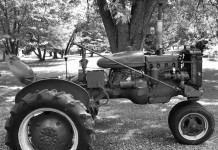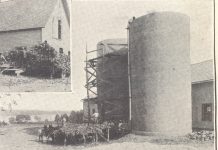I’ll continue the story of my Korean experience, and try to work in some references to Rusty Iron, although rust was just as thoroughly despised by the Army brass as dirt.
I left for the Far East about the end of October, 1953, and had my very first airplane ride from Pittsburgh to Chicago, where I boarded a troop train for the west coast.
After several days on the train, pulled by steam engines, where I got my first look at the corn fields of Illinois and Iowa, the wheat fields of Kansas and eastern Nebraska, the Rocky Mountains, and then the lush farmland of California, I landed at Camp Stoneman, near Pittsburg, California, where I spent about a week.
Then, as though there was a critical shortage of tank drivers in Korea, three of us privates were hustled onto a military air transport service plane, along with a bunch of officers, and we were off to Japan.
The flight was long, about 36 hours, with stops in Honolulu and Wake Island, where the terminal was a steaming hot (we were wearing winter uniforms), metal building, and one could see wrecked Japanese tanks, as well as sunken ships in the harbor.
In Japan.
We finally landed in Tokyo, and were taken to an old Japanese army camp outside town. After all the rush to fly us to Japan, we spent three weeks at the camp, where I experienced my first earthquake.
We made several trips into Tokyo and saw some of the sights, including the Ginza. Then onto a Japanese troop train, with canvas hammocks instead of seats, for the trip south through Japan to the port of Sasebo, where we boarded an old motor boat.
After an all night trip across the Korea Straight, we landed at Pusan on the southern tip of Korea. Here we boarded an ancient train, pulled by a steam engine.
The passenger cars had hard, wooden bench seats, along with a large pipe through the floor to serve as a latrine. As we slowly traveled north toward the demilitarized zone, we met several trains of American troops heading south and home.
Horror stories.
They took no pity on us recruits, and at every stop regaled us with stories of the terrible things the Chinese and North Koreans were going to do to us.
At last, we reached the headquarters of the 2nd Infantry Division, to which we’d been assigned.
I was put on guard duty my very first night in Korea, and was armed to the teeth with a night stick! My entire four-hour shift, I spent in total darkness, clutching my useless night stick and facing north from where the Commies were sure to infiltrate.
The next morning, I realized that I’d been facing south the whole time. Then on to my assigned unit, the Tank Company of the 38th Infantry Regiment.
Change.
The company commander needed communication men more than he needed tank drivers, so another replacement and I were detailed as commo men.
I was disappointed at first, because the company Page I 07-08-2010 was equipped with old World War II M4E8 tanks that had 500 HP Ford V-8 engines, five speed transmissions, and steering clutches. I thought they’d be fun to drive, but never got the chance.
The commo job turned out to be easier than being a tanker, although having to go out at night to find a break in a phone line running to one of the front line platoons wasn’t very enjoyable.
I usually got stuck with this job because I was the youngest, but it wasn’t too bad, except for when I had to pass through the position of the Dutch battalion that was attached to the 2nd Division. I was always afraid the Dutch sentry wouldn’t understand my response to the password and would shoot me. He never did though!
Rusty machine.
The company motor pool had an old tank retriever that was powered by a radial engine. I don’t remember the make of engine, but I think it had seven cylinders and it sounded just like an airplane when they wound it up. Now that machine had some rust, as did most of the old tanks.
Sometime in the summer of 1954, the 2nd Infantry Division was disbanded and rotated home (I didn’t get to go with them), and all our equipment, including the tanks, was turned over to the Republic of Korea Army.
By this time, I was a “communication specialist,” so I was transferred to an infantry battalion headquarters company in the 17th Infantry Regiment of the 7th Infantry Division. No tanks, but lots more telephones, and telephone wire to run.
Early start.
While in this outfit, I was, for a while, given responsibility for the portable generator, a 10KW unit powered by a Jeep engine. I had to get up an hour or so before everyone else to start the generator for the cooks to make breakfast.
I also had to stay up until midnight or later before shutting the thing down. Luckily, it didn’t need to be run during daylight, so all I had to do all day was a little maintenance on the machine.
Everything was great, until one dark night the engine ran out of gas. I got a 55-gallon drum from the POL (fuel) dump, connected up the line to the generator, and restarted the engine. It ran for only a couple of minutes and died, never to run again (until it was overhauled).
We found that someone had delivered a drum of Napalm (jellied gasoline) to the POL dump by mistake, and the little Willys engine didn’t like that at all.
Heading home.
My time was finally up in April of 1955, and I was taken to Inchon and put aboard a troop ship bound for Seattle, Washington. It was a good voyage, but that two weeks seemed like two months.
At last we got to Seattle, and then another long train ride back to Chicago, where I was released from active duty, only to volunteer for the active Army Reserve where 1 spent 15 years. I had a lot of fun in the Army, and greatly enjoyed most of it.
(Send suggestions, comments or questions to Sam Moore in care of Farm and Dairy, P.O. Box 38, Salem, OH 44460-0038; or via e-mail to: editorial@farmanddairy.com)












